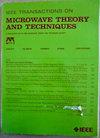A Configurable Multimode Nonuniform Eye-Opening Monitor for High-Speed Wireline Communication Achieving 3-μs EW/EH Evaluation and 0.98-R² Accuracy
IF 4.1
1区 工程技术
Q2 ENGINEERING, ELECTRICAL & ELECTRONIC
IEEE Transactions on Microwave Theory and Techniques
Pub Date : 2025-01-22
DOI:10.1109/TMTT.2025.3528001
引用次数: 0
Abstract
This article presents a configurable multimode eye-opening monitor (EOM) with nonuniform sampling and quantization for an on-chip high-speed link built-in self-test (BIST). The EOM can operate in three modes, enabling it to not only capture the color-graded eye diagram but also rapidly outline its contour, eye height (EH), and eye width (EW). In the nonuniform scanning mode (NSM), the EH and EW are swiftly measured using an optimization algorithm to adjust the control codes of a phase interpolator (PI) and a digital-to-analog converter (DAC). In the fast-multisampling mode (FMSM), the reduced number of samples in each pixel facilitates a prompt generation of the eye contour. The EOM can also reconstruct the eye diagram in the multisampling mode (MSM) by analyzing the probability density function (PDF) of a实现3 μs EW/EH评估和0.98 r²精度的高速有线通信可配置多模非均匀开眼监视器
本文介绍了一种用于片上高速链路内置自检(BIST)的非均匀采样和量化的可配置多模开眼监视器(EOM)。EOM可以在三种模式下工作,使其不仅可以捕获颜色分级的眼图,还可以快速勾勒出其轮廓,眼高(EH)和眼宽(EW)。在非均匀扫描模式(NSM)下,利用优化算法调整相位插值器(PI)和数模转换器(DAC)的控制码,快速测量EH和EW。在快速多采样模式(FMSM)中,每个像素中减少的采样数量有助于快速生成眼睛轮廓。EOM还可以通过分析$128\times 63$像素阵列的概率密度函数(PDF)在多采样模式(MSM)下重建眼图。EOM采用28纳米CMOS技术制造,在0.005 mm2的面积内可以达到26gb /s的运行速度。在26gb /s时,它的功耗为14.55 mW,精度超过0.98- $R^{2}$,在MSM中分别占用$933~\mu $ s,在FMSM中占用$597~\mu $ s,在NSM中占用$\sim 3~\mu $ s。
本文章由计算机程序翻译,如有差异,请以英文原文为准。
求助全文
约1分钟内获得全文
求助全文
来源期刊

IEEE Transactions on Microwave Theory and Techniques
工程技术-工程:电子与电气
CiteScore
8.60
自引率
18.60%
发文量
486
审稿时长
6 months
期刊介绍:
The IEEE Transactions on Microwave Theory and Techniques focuses on that part of engineering and theory associated with microwave/millimeter-wave components, devices, circuits, and systems involving the generation, modulation, demodulation, control, transmission, and detection of microwave signals. This includes scientific, technical, and industrial, activities. Microwave theory and techniques relates to electromagnetic waves usually in the frequency region between a few MHz and a THz; other spectral regions and wave types are included within the scope of the Society whenever basic microwave theory and techniques can yield useful results. Generally, this occurs in the theory of wave propagation in structures with dimensions comparable to a wavelength, and in the related techniques for analysis and design.
 求助内容:
求助内容: 应助结果提醒方式:
应助结果提醒方式:


